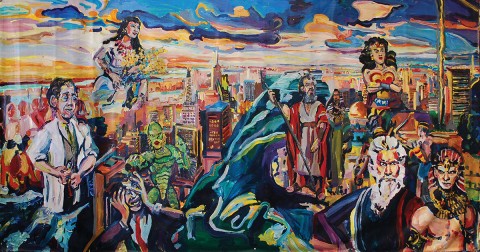Ten Commandments and a Question, by Joel Silverstein

Joel Silverstein’s paintings can be deadly serious and deeply funny, often at the same time. Immersed in comics from a young age and schooled in the pop art movement, Silverstein routinely smuggles comic book heroes and villains into paintings inspired by episodes from the Hebrew Bible and Jewish tradition. Superman somehow feels right at home in the company of less literal luftmenschen, like the prophet Isaiah and the great Jewish philosopher Baruch Spinoza. Meanwhile, movie references ranging from The Ten Commandments to the silent German classic Der Golem jostle alongside images borrowed from famous painters. This jumble of high and low culture and the religious and secular bespeaks a profound insight, at the core of Jewish tradition: Torah “is not in heaven” (Deut. 30:12). God’s words are pronounced in the muddy, impure reality of this world.
In this painting, Silverstein lets loose a chain of unbounded associations, blurring artistic, religious, and cultural boundaries. Inspired by the frescoes of the ancient Dura-Europos synagogue and the grand tradition of academic history paintings, Silverstein conjures a vision of Exodus in contemporary New York. Moses—part Charlton Heston, part self-portrait—commands the waters of the Hudson River, here dividing New York from Jerusalem. In a touch that the artist Philip Guston would have admired, Moses’ staff is also a paintbrush. The miracle is not only the exodus itself but the power to reimagine it.





